|
The Industrial Revolution in Great Britain
The Industrial Revolution was a series of dramatic changes in many areas of work and home life across Great Britain in the 18th and 19th Centuries. 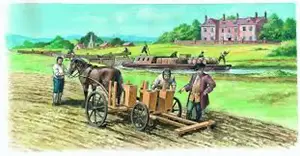
In the early 18th Centuries, advances in agricultural technology increased productivity in that sector of the economy and made it possible for people to produce more food with less work. One of the first agricultural improvements was Jethro Tull's seed drill, in 1701, which made planting more efficient. British farmers also employed a sophisticated method of crop rotation and introduced crops that could infuse the soil with nutrients for the next rotation. All of this innovation freed up workers formerly tied to the farm and gave them the opportunity to pursue new employment elsewhere. Said another way, some farmworkers became surplus to requirements. Textile productionWeaving had been done by hand for a great many years. Women, mainly, but also men spun cotton, flax, and wool in their homes or occasionally in workshops. Britain had imported these raw materials in great numbers for many decades, from ports overseas. Certain inventions in the 18th Century helped speed the production of textiles, sometimes considerably. John Kay in 1733 received a patent for the flying shuttle. Using this simple device, a weaver could use much wider fabrics, effectively creating more cloth in the same amount of time. Several years later, weavers benefited from another time-saving device, James Hargreaves's spinning jenny. The jenny could hold more than one ball of yarn and allowed one Thomas Highs, an engineer, and John Kay, a clockmaker (and not the man who invented the flying shuttle) had run out of money to finance their project of building a new spinning machine. Richard Arkwright, a self-made businessman who had found success as a wigmaker, met Kay and offered to finance his and Highs' project. The result was the spinning frame, which employed three sets of paired rollers turning at different speeds and spindles twisting the resulting fibers together. The result was thread stronger than that produced by the spinning jenny. Two further improvements to the water frame came a few years later. Samuel Crompton in 1779 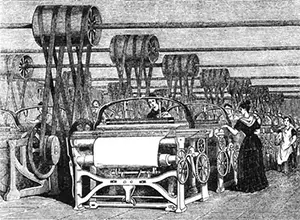
A few years later, Edmund Cartwright, inspired by a visit to an Arkwright factory, invented the power loom, which automated nearly every aspect of the weaving process. People were still needed to repair broken threads, but that was about the extent of the need for human hands in this new device. The power loom proved incredibly popular. By the mid-19th Century, Britain had more than 250,000 of them humming away. Cartwright also invented the wool combing machine, to arrange the wool fibers for ease of use. 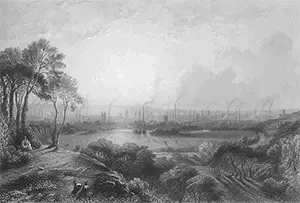
Factories dotted the landscape across Britain. Some cities were home to far more factories than others. Manchester, in particular, was referred to as Cottonopolis because of its large number of textile factories. Such factories emitted large amounts of smoke into the sky, coloring the clouds and the landscape and creating a cover of smog and haze not unknown in modern times. The first air pollution laws, the Alkali Acts, came in 1863. Next page > Steam power > Page 1, 2, 3, 4, 5 |
|
Social Studies for Kids
copyright 2002–2024
David White



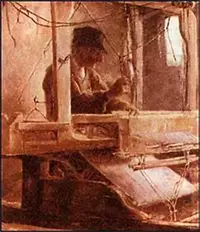 As well, only one person was needed to operate it; previously, it took two people, one on either side of the loom, to make it work. Kay's invention employed one shuttle box on each side of the loom and connected them with a long board, called a shuttle race. The weaver pulled on a cord that sent the shuttle "flying" from one side of the loom to the other; another pull would bring it back again. Kay's invention cut in half the number of people required to operate a loom while also doubling the amount of product that the loom might produce. As well, the flying shuttle worked with automatic machine looms, which could certainly produce more fabric faster than could people.
As well, only one person was needed to operate it; previously, it took two people, one on either side of the loom, to make it work. Kay's invention employed one shuttle box on each side of the loom and connected them with a long board, called a shuttle race. The weaver pulled on a cord that sent the shuttle "flying" from one side of the loom to the other; another pull would bring it back again. Kay's invention cut in half the number of people required to operate a loom while also doubling the amount of product that the loom might produce. As well, the flying shuttle worked with automatic machine looms, which could certainly produce more fabric faster than could people.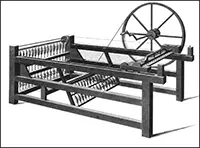 person to turn one wheel and work eight spools at the same time, one on each of the device's eight spindles. The result was a much higher rate of production. Hargreaves had a daughter named Jenny and said that he got the idea for the machine after watching what happened when she knocked over the family spinning wheel and the spindle still spun around. Hargreaves invented the spinning jenny in 1764 and applied for a patent for it in 1770. He died just eight years later. By that time, estimates are that 20,000 of his device could be find in Great Britain alone.
person to turn one wheel and work eight spools at the same time, one on each of the device's eight spindles. The result was a much higher rate of production. Hargreaves had a daughter named Jenny and said that he got the idea for the machine after watching what happened when she knocked over the family spinning wheel and the spindle still spun around. Hargreaves invented the spinning jenny in 1764 and applied for a patent for it in 1770. He died just eight years later. By that time, estimates are that 20,000 of his device could be find in Great Britain alone.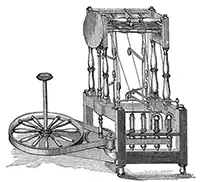 The spinning frame was too big to operate by hand, and so Arkwright turned to horsepower to make the machine work. Seeing only mediocre improvement, he turned to water power. The addition of a water wheel to make the spinning frame was a success, and Arkwright changed the name to water frame. He set up a factory in Cromford, Derbyshire, next to the River Derwent. His factory inspired subsequent inventors and business owners.
The spinning frame was too big to operate by hand, and so Arkwright turned to horsepower to make the machine work. Seeing only mediocre improvement, he turned to water power. The addition of a water wheel to make the spinning frame was a success, and Arkwright changed the name to water frame. He set up a factory in Cromford, Derbyshire, next to the River Derwent. His factory inspired subsequent inventors and business owners.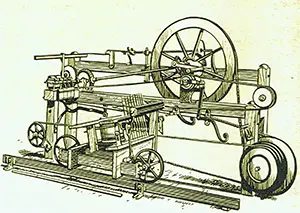
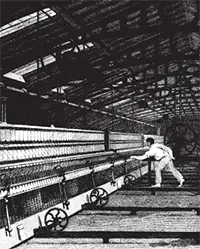 introduced the spinning mule, which was a combination of the spinning jenny and the water frame. The result was a strong yet soft yarn that could be used in all manner of textiles. Crompton couldn't afford a patent and so sold the rights to his invention to a businessman. It wasn't long before really large spinning mules were in operation. Some had 400 spindles. It also wasn't long until someone hooked up a spinning mule to a steam engine and things really got spinning.
introduced the spinning mule, which was a combination of the spinning jenny and the water frame. The result was a strong yet soft yarn that could be used in all manner of textiles. Crompton couldn't afford a patent and so sold the rights to his invention to a businessman. It wasn't long before really large spinning mules were in operation. Some had 400 spindles. It also wasn't long until someone hooked up a spinning mule to a steam engine and things really got spinning.
